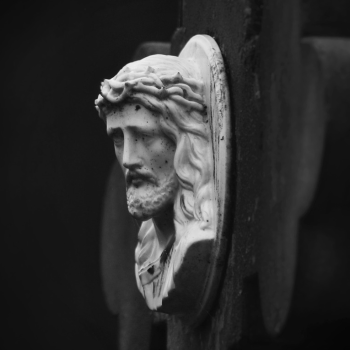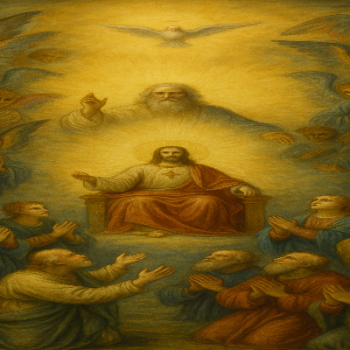
“The Son of Man did not come to be served but to serve and to give his life as a ransom for many.” Matthew 20:28.
As Catholics, the belief that Christ atoned for the sins of mankind is paramount. If human beings are to have any hope of being freed from sin and thereby obtaining eternal life, it can only be because Christ has paid the price incurred by sin.
For the purpose of this paper, I will define atonement as the satisfaction of a demand. In a limited sense, it is taken to mean the reparation of an insult. This occurs through a voluntary performance that outweighs the injustice done. (See Ott, Ludwig. Fundamentals of Catholic Dogma. Tan Books, 1992).
How was this done? How did Christ’s suffering, death, and resurrection effect our atonement?
In this essay, I will examine three of the most widely accepted theories of how Christ’s death paid the price for the sins of so many.
Penal Substitution Theory
The penal substitution theory dates to the Protestant Reformation of the sixteenth century. Its most notable proponents include Martin Luther and John Calvin. Calvinist theologian Charles Hodge is credited with providing a concrete formulation of the theory. More recently, Wesleyan theologian William Lane Craig has argued in support of it.
The theory itself can be understood from its name. Penal means “related to punishment for offenses,” and substitution means “the act of a person taking the place of another.” Within the context of Christian theology, penal substitution argues that Christ acted as the substitute for humanity and took upon Himself the punishment owed to human beings for sin.
Penal substitution can be viewed as building on the scapegoating mechanism found in the Old Testament. Chapter sixteen of the Book of Leviticus describes how the Israelites’ high priest would place his hands over the head of a goat and confess the sins of the Israelite people. In so doing, the people’s sins were “transferred” to the goat, who was then banished from them. This was done to satisfy God’s justice. Still, the scapegoating (and the various other sacrifices) were temporary and imperfect. As such, the perfect justice required by God for the propitiation of sins could not be effected.
According to the doctrine of penal substitution, Christ is the scapegoat par excellence. Jesus’ death on the cross satisfied God’s requirement for justice. God’s mercy allows Jesus to take the punishment we deserve for our sins. As a result, Jesus’ sacrifice is a substitute for anyone who accepts it.
Christus Victor Theory
In 1931, the Lutheran theologian Gustaf Aulen published a book on atonement titled Christus Victor (Christ the Victor). In a sense, Christus Victor is a recapitulation of a much older hypothesis, known as the ransom theory of atonement.
The ransom theory posits that, due to original sin, all of humanity was held captive to the power of the Devil. To free human beings from this captivity, God offered His only Son “as a ransom for many.” The ransom theory further argues that God “tricked” the Devil into accepting Christ’s death as a ransom to free humanity. Once the Devil accepted Christ’s death as a ransom, Divine justice was satisfied. The “trick” is that death could not hold Christ, and His resurrection completes Christ’s victory.
In formulating the theory, the Catholic Church does not go so far as to imply that the ransom was paid to the Devil, only that Christ’s death freed humanity from the bonds of sin. (See Catechism of the Catholic Church, paragraph 601).
Satisfaction Theory
The most widely accepted theory in Catholic theology is the satisfaction theory of atonement, also known as vicarious atonement. Saint Anselm is generally considered the Father of the satisfaction theory. In his seminal work, Cur Deus Homo (Why God became man), Anselm formulates a mostly ontological argument as to why and how Christ saves humanity.
First, the redeemer must be divine (possess a divine nature) since finite humans can not satisfy the debt incurred by infinite sin. However, in order to satisfy divine justice, the redeemer must also be able to provide sufficient sacrifice for the atonement of sins. Therefore, the redeemer must also have a human nature. This means that the satisfaction theory begins with the incarnation. Nevertheless, because sin incurs the penalty of death (Romans 6:23), the redeemer who takes upon himself sin must also suffer death.
So, in dying on the Cross, Christ is the preeminent Paschal sacrifice. He accomplishes the definitive redemption of human beings while simultaneously ushering in the New Covenant, which allows believers to return to communion with God.
“For as by one man’s disobedience many were made sinners, so by one man’s obedience many will be made righteous.’ By his obedience unto death, Jesus accomplished the substitution of the suffering Servant, who makes himself an offering for sin’, when ‘he bore the sin of many,’ and who ‘shall make many to be accounted righteous,’ for ‘he shall bear their iniquities.’ Jesus atoned for our faults and made satisfaction for our sins to the Father.” (See Catechism of the Catholic Church, paragraph 615).
It is quite common when speaking of atonement to conclude that we are saved by Jesus Christ. This is, of course, entirely appropriate and accurate. However, Catholicism asserts that God is triune. It seems fitting, therefore, to conclude this essay by examining what role the Holy Trinity plays in atonement.
The Role of the Trinity in Atonement
In order to speak meaningfully of the Holy Trinity, one must attribute certain activities and properties to particular members of the Trinity. Within Catholic theology, this practice is called appropriation. This is exceedingly difficult, as the three divine persons share one divine essence. For example, one can speak of God the Father as the efficient cause (that which creates), the Son as the exemplary cause (the model for humanity), and the Holy Spirit as the final cause (that for which everything tends toward).
Suffice it to say that the salvation made possible by Christ cannot be deracinated from the Holy Trinity. The Father’s love and providential care, the Son’s sacrificial atonement, and the Holy Spirit’s transformative work collectively contribute to the unfolding of God’s redemptive plan for humanity. The Trinity’s salvific mission underscores the interconnectedness of divine grace and mercy.
In this essay, I have endeavored to provide a brief summary of the three most prominent theories of how Christ effected the salvation of mankind. I have also indicated that the salvific work belongs essentially to all three members of the Holy Trinity.













